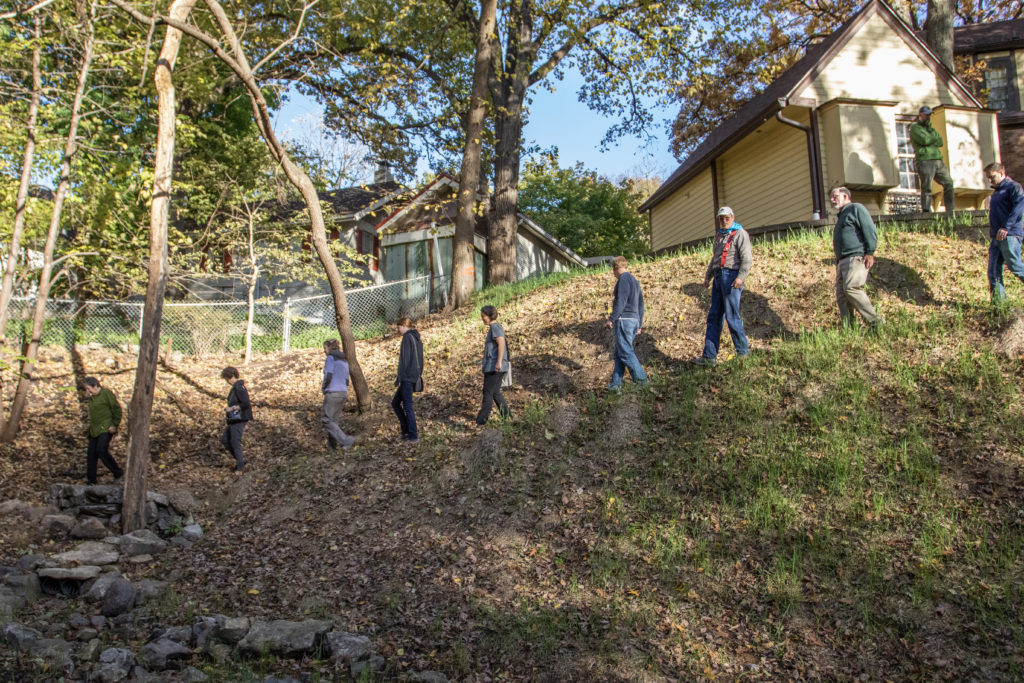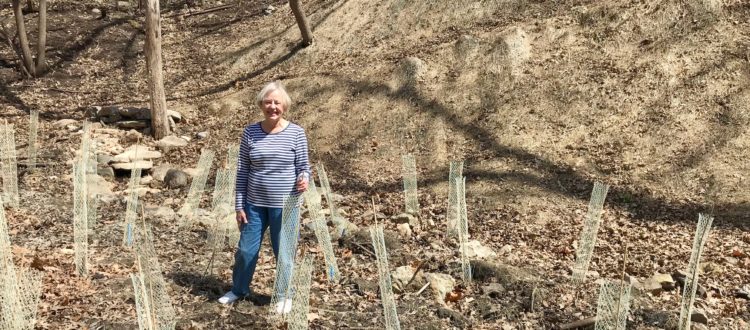Protecting an Urban Woodland from Erosion with Ecology and Engineering
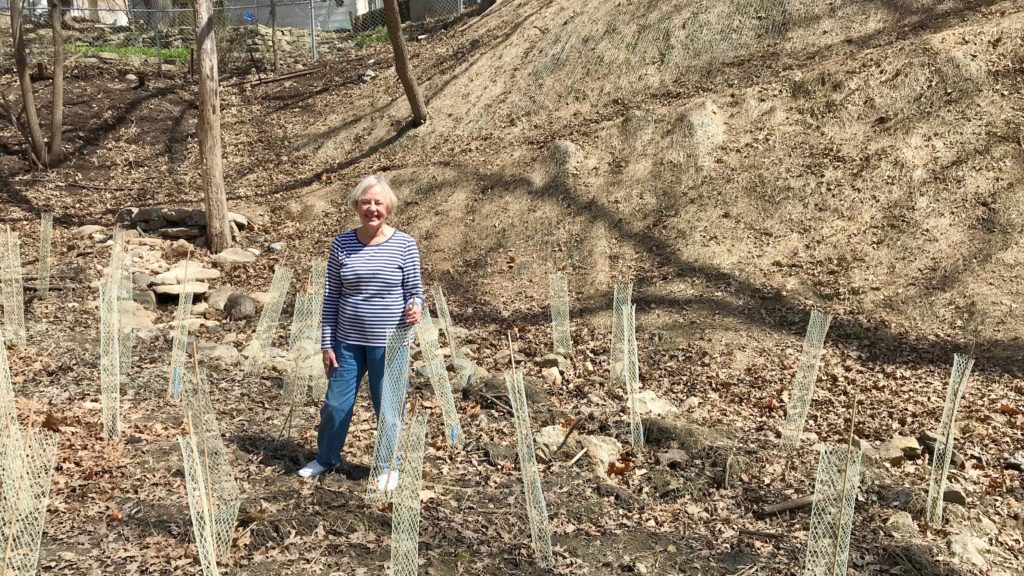
Jeanette LaGrange almost lost her garage to stormwater erosion before finding a long-term solution that improved wildlife habitat, water quality, and access to her backyard forest.
When a large tree came crashing down last spring, Jeanette knew the erosion problem had gotten serious. Her house rests at the summit of a steep hillside overlooking a forested draw near Squaw Creek in Ames. She loved being so close to nature, with an unobstructed woodland view from her back patio. Getting up close to admire wildflowers or manage her land was not an easy hike due to the 40-80% slope. When Jeanette did venture into the woods, the ground was unstable, littered with pieces of concrete and rebar, and prone to crumbling beneath her feet.
For over a decade, she had worked to curb the erosion—placing sandbags where the soil sloughed, reconstructing a railroad tie retaining wall that was damaged in historic flooding, and installing tile tubes to carry water from her home’s gutters to the bottom of the hill. As the soil continued to disappear down the hillside, Jeanette attempted to establish vegetation. Neighbors and nurseries supplied her with bedding plants, from hostas and ferns to pampas grass, but nothing took hold in the high clay soil.
The collapse of the tree had been dramatic, but Jeanette knew that much more was at stake. Next, it could be the garage. “You’re always hoping your land is going to stay, but you can’t predict when [a major erosion event] is going to happen. I knew it was sort of in trouble.”
When Prudenterra forester Luke Gran stepped into her backyard, she could tell that his approach to managing erosion was different from the landscapers who had advised her previously. What Luke saw was a highly disturbed forest with a complicated past. He recounted, “There were layers of soil—bands of change where generations of humans had tried to stabilize the site. It was mostly clay, fill dirt, chunks of rock, and junk [from back when ravines were used as landfills].”
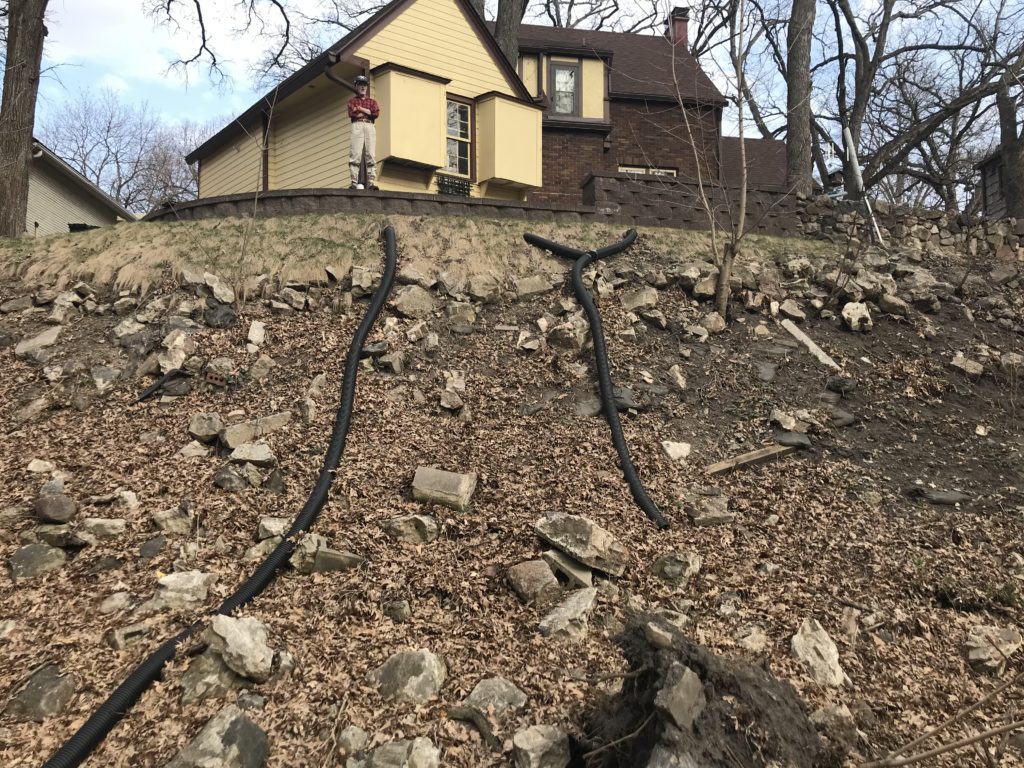
Site Analysis
Before he could halt the erosion for good, Luke would need to pinpoint its causes in a site analysis. Historic soil data, aerial images, and current vegetation revealed that Jeanette’s land had been an oak savanna, where white and upland bur oaks thrived alongside prairie grasses and wildflowers in rich, loamy soil. When European-descended settlers displaced indigenous Iowans, savanna burning ceased. Over time, native ground vegetation was shaded out by shallow-rooted invasive and ornamental plants, ill-equipped to hold soil in place or offer habitat for native fauna.
Urbanization
Stormwater drainage became an existential threat in the 1930s, when a neighborhood of streets and houses first masked the soil with impervious surfaces. In the site analysis, Luke calculated that over half of Jeanette’s land is covered by her roof, driveway, concrete patio, and sidewalk. In a gentle 1.25” rain, two dumptrucks-worth of water falls on her urban lot. Gravity draws almost all of it into her backyard, where it picks up speed and soil particles as it descends the slope.
In an attempt to stem the tide, drainage tiles had been laid on the surface a decade ago to ferry gutter water down the hill. Unfortunately, these leaky tubes were causing problems of their own: plants beneath the large black plastic tubes were shaded from sunlight, creating bare soil. With each downpour that passed through the leaky tubes, erosion channels continued to carve into the hillside.
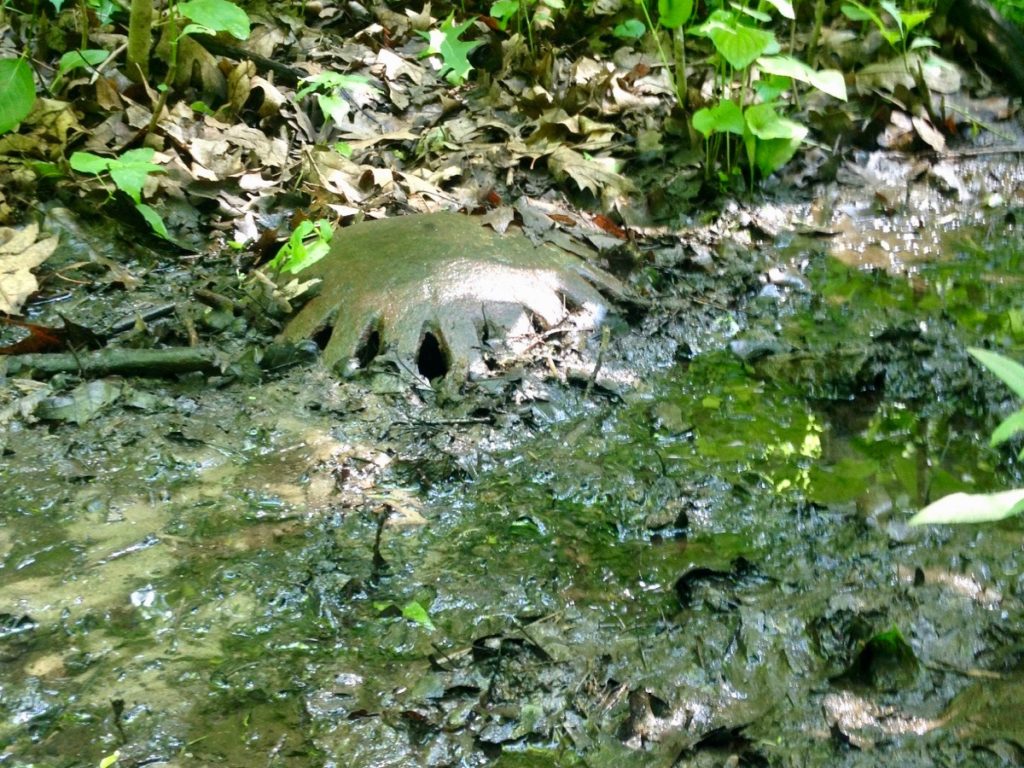
History Revealed in the Soil
Luke set to work to unearth the full story with a soil probe. Tests corroborated Jeanette’s observation that the ridge was abundantly high in clay. Indeed, most of the original loam had either sloughed down to the bottom of the slope or had been carried, suspended as sediment, into Squaw Creek. The scant topsoil that remained had been masked by a low quality, heavy clay fill material, placed over generations of unsuccessful construction projects that had aimed to hold up the hillside.
At the base of the hill, a thick layer of fine, loamy sediment confirmed its erosive history. In the not-too-distant past, Jeanette had been able to walk across it without making a dent, but it had become mucky in recent years. A soil probe revealed that the water table was just five to ten inches beneath the surface–surprisingly shallow for its high position on the landscape. The water was flowing, but from where? Could there be a disruption in the city’s stormwater sewer system contributing to the instability of the slope? Without definitive evidence, it remains undetermined.
A bare patch of what should have been fertile soil at the bottom of the slope raised another red flag. Pieces of junk had disclosed that the hillside had been someone’s landfill. Could it have been their waste oil dumpsite as well? Alternatively, any leak in buried municipal stormwater drainage pipes could deposit pollution from city streets. Albeit source unknown, soil testing verified a small amount of waste oil pollution.
The site analysis had uncovered how non-native vegetation, impervious surfaces, and other recent disturbances had destabilized Jeanette’s backyard. Now it was time to design a restoration that integrated all of her objectives:
- Slow soil erosion; protect garage and retaining wall
- Improve access to and enjoyment of the woodland; enhance beauty with wildflowers
- Increase wildlife habitat; leave a legacy of ecological restoration for future homeowners
- Reduce long-term management time and expenses; boost property value
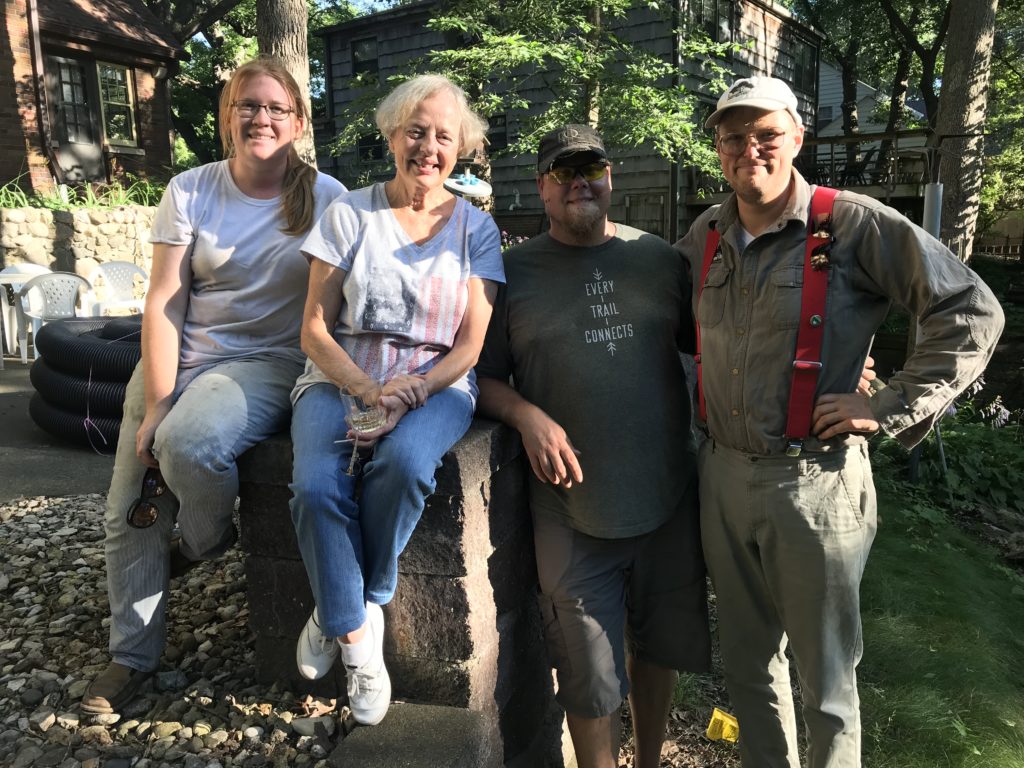
Restoration
In such an altered landscape, ecological restoration alone would not be enough–it would need to be combined with engineering techniques to redirect the flow of water and physically hold the soil in place. Luke teamed up on planning with Annie Fangman, Prudenterra Project Manager (and Bachelor of Landscape Architecture) and Pete England, trail-building expert and owner of Legacy Trails, LLC.
For Jeanette, this evidence-based, integrated approach made sense in a way that the prior strategies had not. “For a long time, maybe we relied on the wrong people and the wrong things. Whereas if we just get back to nature we will possibly be more successful.”
Engineering the Flow of Water
The initial transformation of Jeanette’s backyard took place over three weeks in the summer of 2018. The first step was to remove impediments to restoration–metal rebar, chunks of concrete, and undesirable plants. “The vegetation on the site was mostly honeysuckle, ash, elm, Japanese tree lilac, so there was insufficient sunlight,” explained Luke. “A better alternative is to grow diverse plants whose living roots can build more water holding capacity in the soil itself and use the water to grow shoots to purify air, enhance aesthetics, support pollinators.”
Next, the old, leaky tubes were rerouted and replaced by new, non-perforated tile with leak-proof fittings which was buried underground. When the water emerged at the bottom, it entered two stilling pools–basins of carefully placed rocks to defuse the sediment-starved, fast-moving water.
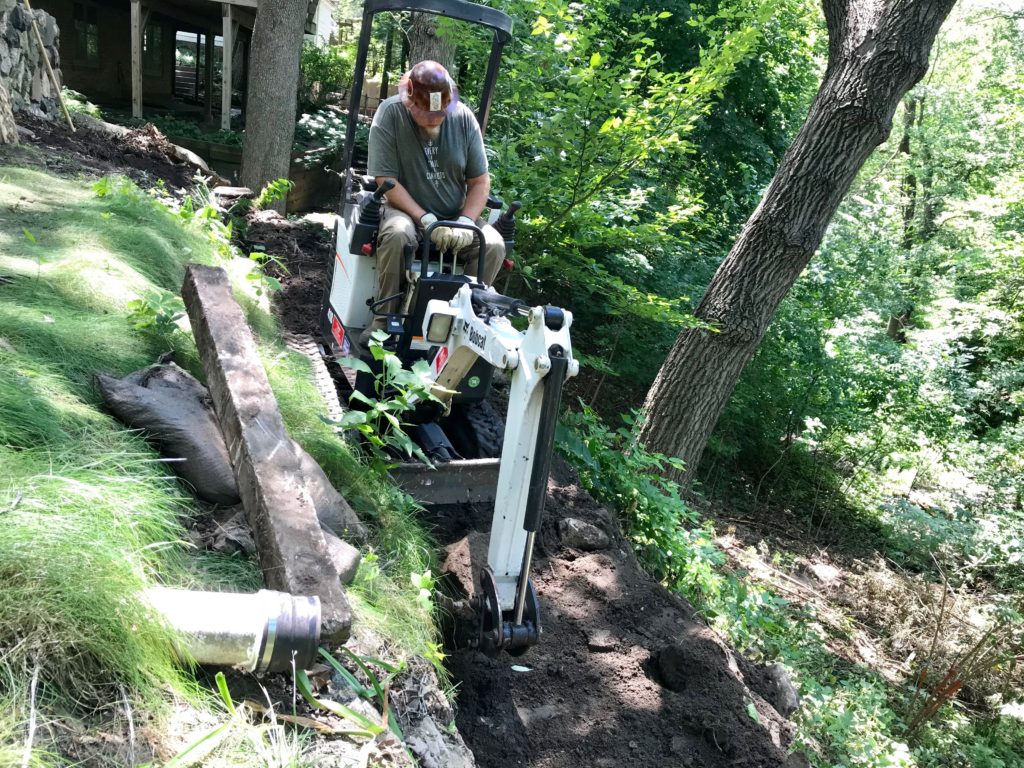
Improving Access with a Trail
Above the tile trench, perpendicular to the hill in a gently-graded switchback, Prudenterra’s team saw an opportunity for Jeanette to finally be able to comfortably walk down into her backyard woodland. The tools for trail construction would already be on site, and it would cost marginally more to create a trail down to the stilling pools, where she could observe the heart of the restoration.
Increasing enjoyment and accessibility of the woodland was one of her objectives, but Jeanette was conflicted about whether she should increase costs with a non-essential component. “ At the time I thought, ‘maybe I should just do a wall of some sort’. But now with the trail it is usable. I can get down there easily. I’m so glad I did the trail.”
Establishing native plants takes a few years, and steep slopes without living cover are at risk of washing away in a rainstorm. Across the ridge and at the bottom of the hill, Prudenterra’s team unfurled Geoweb®, a bio-cell material that holds soil in place while roots grow in around it. It was early August, and since the native plants would not be seeded until the fall, Prudenterra broadcast oats as a fast-growing cover, and then rolled out a straw mat over them for extra erosion protection. It turned out to be a fall of heavy rains, but for the first time in decades, the soil stayed put.
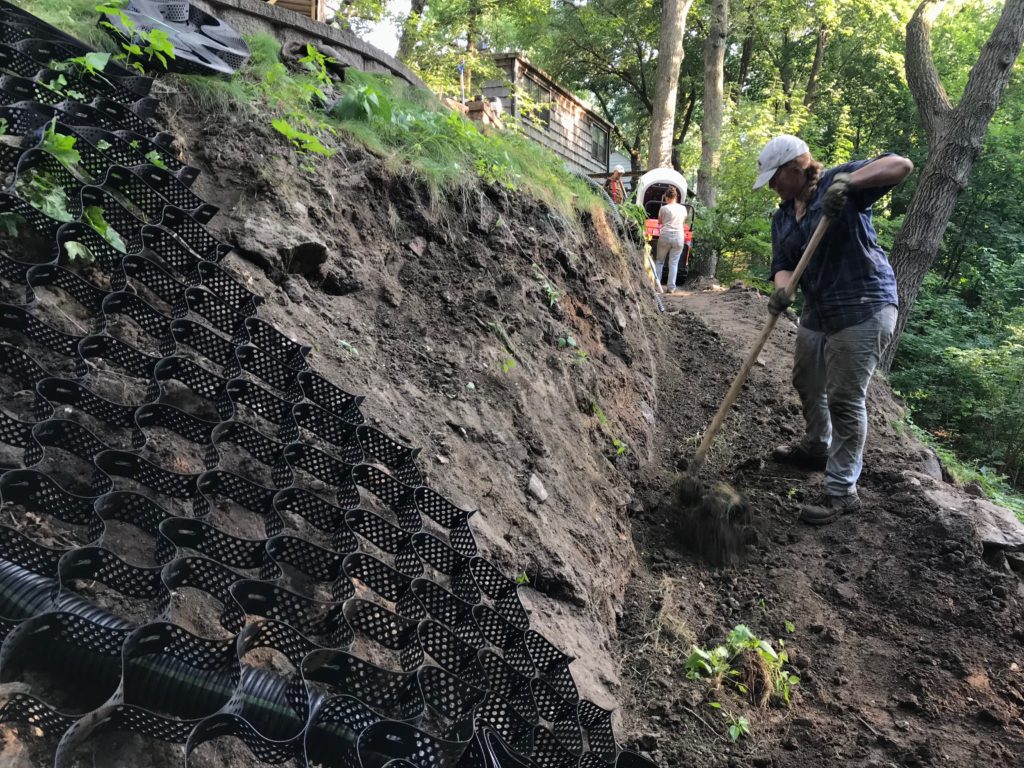
Native Plant Reconstruction
In October, the hillside was seeded with 63 species of savanna plants such as bottlebrush grass, side-oats grama, brown-eyed susan, and round-headed bushclover. On the ridgetop, they broadcast sun-loving prairie plants like tick trefoil and wild bergamot, and at the base of the slope, coralberry and other woodland dwellers.
When November arrived, freshly cut dormant branches from native silky and redosier dogwood, highbush cranberry, bladdernut, and elderberry shrubs were tapped into the soil at the foot of the hill, deep enough to be partially submerged in the water table. Each “live stake” will sprout its own roots and branches, making an inexpensive alternative to shrubs grown in containers.
Phytoremediation
Like the site’s existing vegetation, these native shrubs will not be able to grow in the soil made barren by waste oil contamination. Fortunately, plants in the willow family can tolerate hydrocarbons. As they grow, willows pull pollutants out of the soil and store them in their tissues. This makes them perfect partners in phytoremediation–the practice of using plants to clean up pollution. After five years of rapid growth, the willows will be cut, removed from the site, and set alight to incinerate the hydrocarbon. As the pollutant disappears, the dogwoods, elderberry, bladdernut, and highbush cranberry will inch their way into the former deadzone, eventually replacing the willows.
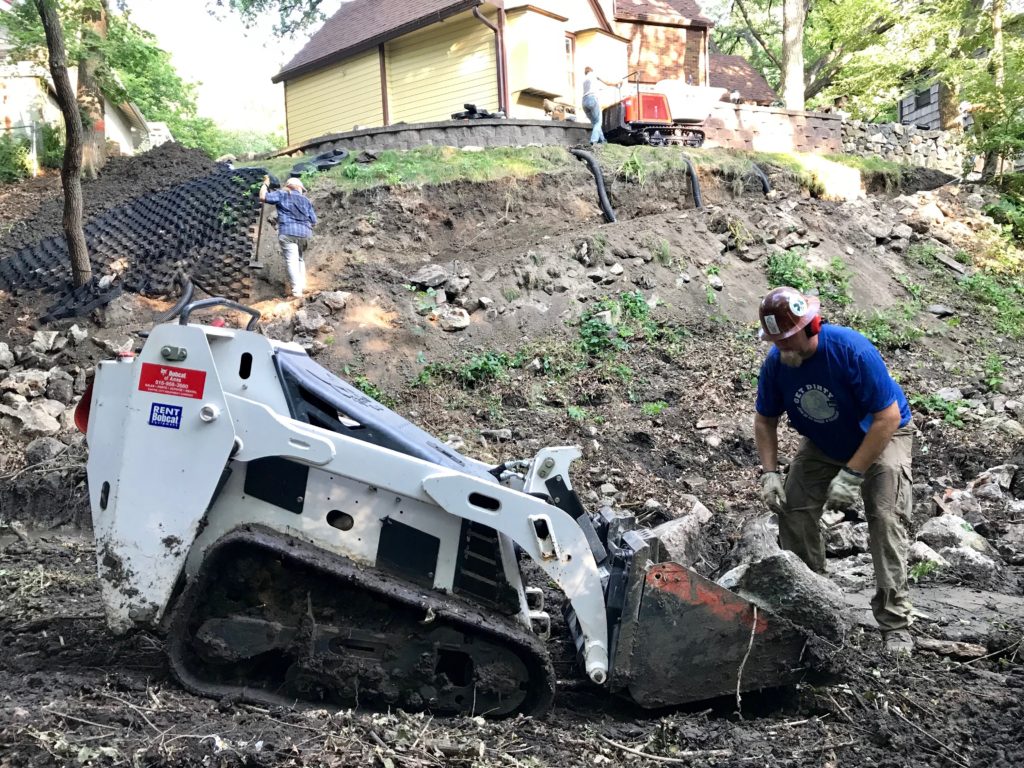
Establishment
The next few years will be critical to making sure that the young plants can fend off competition from faster-growing annual weeds. Periodically mowing the ridge with a weed wacker will help young prairie seedlings get enough sunlight, and herbicide applications around the base of young trees and shrubs will shield them from both weed competition and rodent damage.
Over the seasons to come, the real impact of the project will unfold, but Jeanette is already delighted with the transformation. “Luke came, we worked together, and voila, we have a park in the backyard,” Her experience inspired her to become a neighborhood advocate for long-term erosion management strategies rooted in ecological restoration.
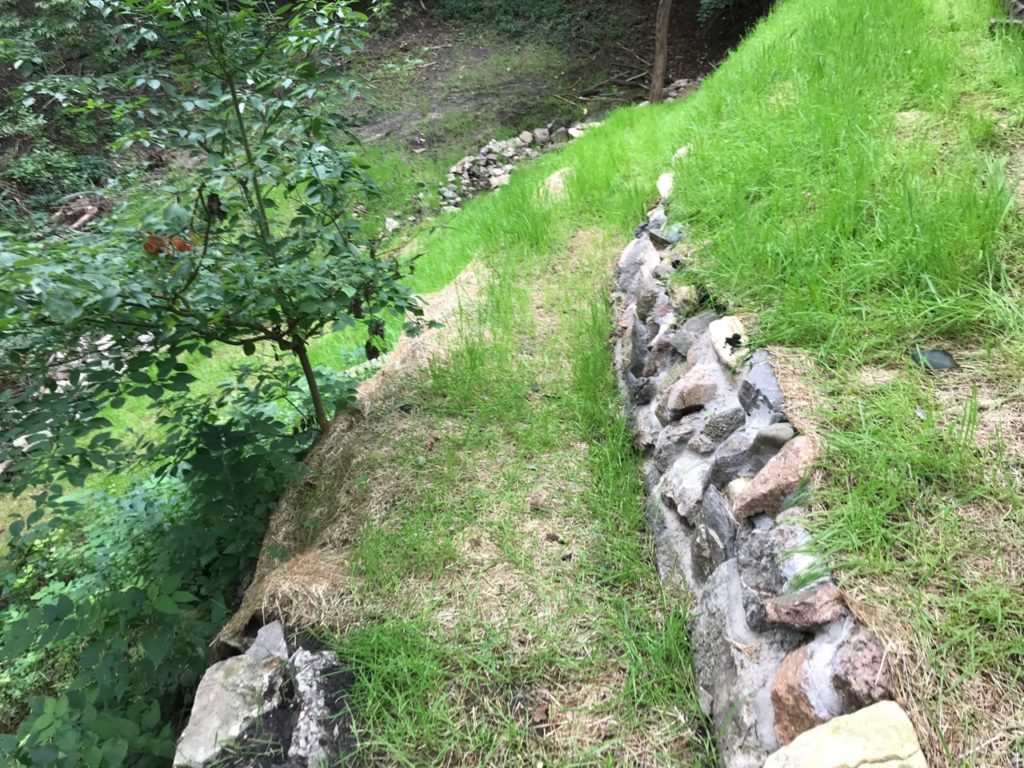
Multiplying the Impact of Restoration
“The neighbors certainly have erosion problems, all the way down to the end of our street,” explained Jeanette. She hosted a gathering to allow them to hike the backyard trail and get an up-close glimpse of how the Geoweb®, stilling pools, and living roots were holding up in the heavy fall rains. As a result, four neighbors have begun to implement long-term, ecologically restorative erosion management strategies.
“Homeowners have responsibility for the land we have. I feel that the more people we get on board, the more success we will have as a community. Maybe it won’t be in my lifetime, but we have got to do things to preserve.” She and Luke brought that message when they guest lectured at an Iowa State University soil science class and showed Junior Foresters from Nevada’s Central Elementary around the site.
With heavy rains and flooding on the increase, Jeanette’s backyard has become a case study for urban stormwater mitigation. The impacts of the restoration do not stop at the border of her urban lot. By slowing the flow of water, enabling it to infiltrate into the soil, and using living roots to filter pollutants, it will improve water quality and reduce flooding for people and ecosystems who live downstream.
Jeanette turned a frustrating soil erosion problem into an opportunity to make a meaningful impact on her land and community. In saving her garage and patio, she has created a legacy of stewardship–a backyard haven for wildlife that she can finally enjoy spending time in, too.
